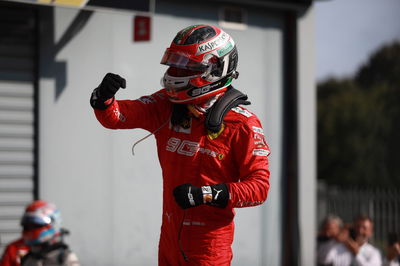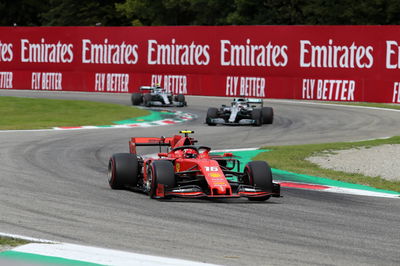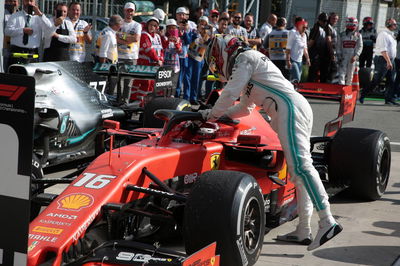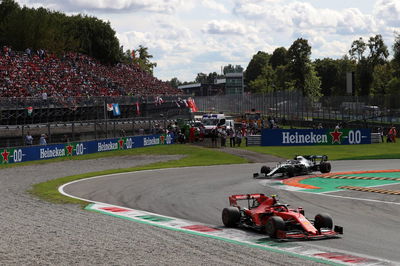F1 Race Analysis: How Leclerc defeated Mercedes single-handedly
History almost repeated itself at Monza on Sunday. One year on from Mercedes’ masterful victory, snatched from Ferrari in its own backyard after some excellent teamwork between Lewis Hamilton and Valtteri Bottas to get the jump on Kimi Raikkonen, a similar tactic almost paid dividends again on Sunday.
But Charles Leclerc had other ideas, holding on to give Ferrari its first Italian Grand Prix victory since 2010, ending the Tifosi’s long drought of seeing a driver in red on the top step of the podium.

History almost repeated itself at Monza on Sunday. One year on from Mercedes’ masterful victory, snatched from Ferrari in its own backyard after some excellent teamwork between Lewis Hamilton and Valtteri Bottas to get the jump on Kimi Raikkonen, a similar tactic almost paid dividends again on Sunday.
But Charles Leclerc had other ideas, holding on to give Ferrari its first Italian Grand Prix victory since 2010, ending the Tifosi’s long drought of seeing a driver in red on the top step of the podium.
Similar to Raikkonen 12 months ago, Leclerc was left fighting solo at the front of the pack after a clumsy mistake from Sebastian Vettel. Becoming the latest addition to the long, long, long list that has developed in recent times, Vettel dropped his car at Ascari, spinning off the circuit. An unsafe return to the track resulted in a 10-second stop/go penalty, adding insult to injury.
Vettel’s race was done after six laps – but the bigger worry for Ferrari came with Leclerc. While he had held his advantage from pole and opened up a slender margin over Hamilton behind, he had two Mercedes cars sitting within four seconds of him.
Mercedes won last year’s race with three steps: first, pitting Hamilton early to try and get the undercut on Raikkonen; then keeping Bottas out long so he could back Raikkonen up and into Hamilton behind; then letting Hamilton complete the job by passing Raikkonen on-track.
This time around, Bottas was close enough that he could be a genuine contender for victory. The split between early-stoppers and longer-runners seen at Spa could emerge again, only this time, Leclerc had no choice but to respond to Hamilton and come in early.
Mercedes blinked first by bringing Hamilton in at the end of Lap 19 to try and get the undercut on Leclerc, fitting the Briton with Medium-compound tyres. Mercedes had ruled out running Hards in the second stint as its engineers were unsure about the lap times, despite Hamilton requesting to use them on Sunday morning. Leclerc came in one lap later, going for Hards that would see him to the end – albeit leaving him at risk of being overtaken early in the second stint.
“The Plan B was simply a longer first stint, and not a too early stop,” explained Ferrari chief Mattia Binotto after the race. “The reason for the choice of the Hard is simply that we looked at the lap times. We were looking at the [Medium], degradation over the stint was not critical but was there, and we knew by putting the Hard we would not have that at the end of the race.
“With the others on the Medium, we knew that after the stop, the very first laps would be difficult, that’s why I think it was a key point of the race for the win and the victory.
“I think the choice was brave but the right one.”

Leclerc’s defence of Hamilton could also be described as being ‘brave’, with his aggressive approach adopted in the wake of his defeat to Max Verstappen in Austria paying off. Race control threw the black-and-white flag to warn Leclerc about moving under braking, but most were content with the hard racing that unfolded.
Running on the Mediums, Hamilton knew that his best chance to jump Leclerc had passed by in that first run-in at the Roggia Chicane when the delta between the two tyre compounds was at its greatest. All of a sudden, Bottas was coming into contention as Mercedes’ better bet for victory.
The long first stint strategy has been effective at several races this year – see Austria; Spa – giving Bottas hope of charging through and making up the time he had lost. He came in eight laps later than Hamilton, also opting for Mediums, and emerged around nine seconds off the battle for the lead. He was unfortunate not to come in one lap later when the Virtual Safety Car was out, as the reduced pace of the field would have played into his hands, but he still had fresher boots with which to carve into the gap ahead.
But Monza has never been a track known for being hard on tyres, meaning the kind of gains seen at races earlier this year was not possible. Bottas initially made up around one second per lap as Hamilton and Leclerc scrapped for the lead, but the margins soon fell, meaning it would take 12 laps to get near to the lead duo.
Leclerc remained aggressive in his moves to keep Hamilton back, getting away with a lock-up at Turn 1 that forced him to run across the kerbs. Race director Michael Masi noted that he had gone off track, but the stewards deemed no action necessary after looking at the mini sectors which showed Leclerc had not gained an advantage.
Hamilton was next to make an error as his tyres neared the end of their life, having been hurt by the dirty air thrown off Leclerc’s car and the various backmarkers both had come across. A lock-up at Turn 1 saw Hamilton take to the escape route. By the time he had finished weaving through it and returned to the track, Bottas has swooped past into second place. The Finn was now Mercedes’ only chance of victory.
Ferrari’s decision to fit Leclerc’s car with Hard tyres again paid off, though. Bottas may have been on fresher rubber, but Leclerc’s was holding up just fine. The might of the Ferrari in a straight line also meant Bottas had no real chance of getting close enough to even try a pass, giving Leclerc breathing room to the chequered flag.
Leclerc had single-handedly defeated Mercedes. The 21-year-old needed no rear gunner – even if that choice was taken away from him.
“Obviously we were in a tricky situation because we had the two Mercedes behind. and I was the only Ferrari,” Leclerc said. “They could play the game of going long with one car and earlier with the other. It was very tricky, but in the end, I think we made the right choice with the Hard.”

While Leclerc may have called it a “tricky situation”, a later answer after the race suggested he hadn’t factored Vettel in that much anyway. Asked how much he missed the support of his teammate, Leclerc cited qualifying – not Vettel’s spin – as being the cause.
“Obviously it’s always an easier situation to have two cars instead of one,” Leclerc said. “But obviously yesterday Seb was extremely unlucky, he couldn’t do the lap in the second run of Q3. I’m pretty sure it will be better in the next races.”
It wasn’t like Vettel was starting last as a result of the qualifying snafu so many were caught out by. He was still P4 on the grid; still within firing range to help Leclerc out, similar to what he did in Spa. But did needing assistance even cross Leclerc’s mind?
Sunday’s race at Monza offered a spirited battle for victory that was settled on-track thanks to the straightforward strategy options. And for the second week in a row, Ferrari got it right while Mercedes was ever-so-slightly off the mark.
But the real star was Charles Leclerc. After nine long years, the Tifosi has a win to celebrate once again – and a new hero to cherish.











